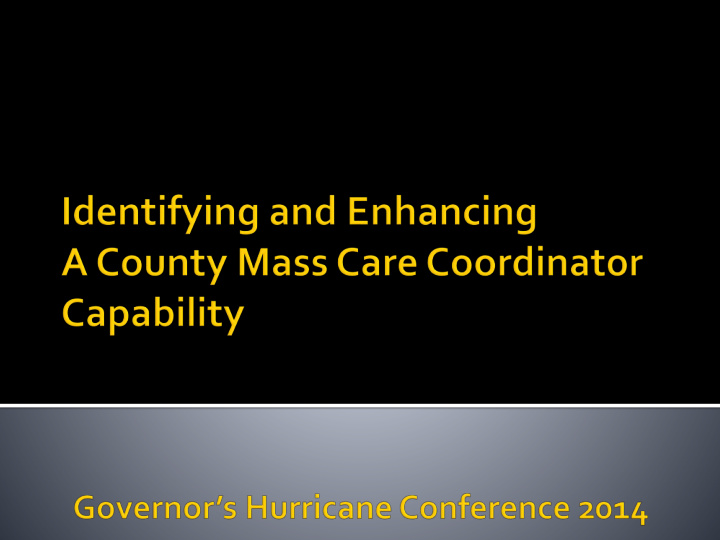



2
County Mass Care Coordination Process Response Phase Internal Local Local Food unaffiliated VOADs Bank agencies COUNTY EOC TSA ARC Local Local ARC LIAISON Chapter Corps TSA LIAISON County State agencies Agencies External State TSA State State MC ARC Relief Incident Agencies Coordinator Operation CMD 3
Assess local/state mass care coordination planning capability. Identify & train Mass Care Coordinators
Where do these County MCC candidates come from? What would a County MCC need to know? 5
TYPE TYPE 1 TYPE 2 A Type 1 State Mass Care Coordinator is responsible for leading and coordinating mass A Type 2 State Mass Care Coordinator is responsible for coordinating and assisting in care and emergency assistance resources in support of those providing care and shelter the coordination of components of mass care and emergency assistance resources in DESCRIPTION services to the survivors of a disaster. support of those providing care and shelter services to the survivors of a disaster. CATEGORY CRITERIA CRITERIA Not specified Not specified EDUCATION NOTES: Not Specified 1. IS/ICS-100: Introduction to Incident Command System (ICS). Same as Type 2, PLUS: 2. IS/ICS-200: ICS for Single Resources and Initial Action Incidents. 1. FEMA Mass Care Planning and Operations Course. 3. IS/ICS-300: Intermediate ICS for Expanding Incidents. 2. IS-293: Mission Assignment Overview. 4. IS/ICS-400: Advanced ICS Command and General Staff – Complex Incidents. 3. G108: Community Mass Care Management. (NIMS Advanced Professional Series). 5. IS-700: National Incident Management Systems (NIMS), An Introduction. 4. IS-288: The Role of Voluntary Agencies in Emergency Management. 6. IS/ICS-701: NIMS Multiagency Coordination System (MACS) Course. 5. IS-366: Planning for the Needs of Children in Disasters. 7. IS-775: EOC Management and Operations. 6. IS-11: Animals in Disasters, Module B: Community Planning. 8. IS-800: National Response Framework (NRF), An Introduction. TRAINING 9. IS-806: Mass Care, Emergency Assistance, Housing, and Human Services. 10. IS-10: Animals in Disasters, Module A: Awareness and Preparedness. 11. Training on FEMA National Shelter System (NSS) or American Red Cross National Shelter System (NSS). NOTES: Not Specified Same as Type 2, PLUS: Knowledge, Skills and Abilities: 1. Knowledge of emergency response planning. Knowledge, Skills and Abilities: 2. Knowledge of mass care shelter operations. 1. Knowledge and understanding of the functional needs and services of special populations as defined in the National Response Framework (NRF). 3. Knowledge of procurement for feeding operations and/or accessing United States Department of Agriculture (USDA) resources. 2. Knowledge of the role of voluntary agencies in delivering mass care during an incident, such as with entities associated with the National Volunteer Experience: Organizations Active in Disaster (NVOAD). Operational experience in an Emergency Operation Center (EOC). (e.g., the American Red Cross, the Salvation Army, and other faith community-based organizations as appropriate for the emergency situation). EXPERIENCE 3. General operational knowledge of logistical support systems or procedures. Experience: 1. Operational experience in providing human services-related activities. 2. Operational experience in coordinating assistance with State, local, and Tribal governments and nongovernmental organizations conducting mass care. 6 NOTES: Not Specified
TYPE TYPE-I TYPE-II A TYPE-I County Mass Care Coordinator is responsible for coordinating mass care and A TYPE-II County Mass Care Coordinator is responsible for coordinating mass care and emergency Description emergency assistance resources in support of those providing care and shelter services to assistance resources in support of those providing care and shelter services to the survivors of a disaster the survivors of a disaster within a jurisdiction in excess of 500,000 persons. within a jurisdiction of less than 500,000 persons. Category Criteria Criteria Not specified Not specified Education Same as Type II plus: Completion of the following courses/curricula: Training 1. ICS-/IS-100: Introduction to Incident Command System (ICS). 1. FEMA Mass Care Planning and Operations course 2. ICS/IS-200: ICS for Single Resources and Initial Action Incidents 2. IS-197.SP: Special Needs Planning Considerations for Service and Support 3. ICS-300: Intermediate ICS for Expanding Incidents Providers 4. ICS-400: Advanced 3. IS-288: Role of Voluntary Agencies in Emergency Management 5. IS-700.A: National Incident Management System (NIMS), An Introduction. 4. IS-11 Animals in Disaster, Module B: Community Planning 6. IS-701.A: National Incident Management System (NIMS), Multiagency Coordination System 5. IS 366: Planning for the Needs of Children in Disasters (MACS) 7. IS-800.B: National Response Framework, An Introduction. 8. IS-806: Mass Care, Emergency Assistance, Housing, and Human Services 9. IS-197 EM: Special Needs Planning Considerations for Emergency Management 10. IS-10 Animals in Disaster, Module A: Awareness and Preparedness 11. NIMS Advanced Professional Series course G108: Community Mass Care Management 12. State emergency operations center procedures as specified by the Authority Having Jurisdiction (AHJ) Same as Type II plus: 1. Operational experience in an Emergency Operation Center (EOC) Experience 2. Experience with or understanding of mass care shelter operations 1. Operational experience in coordinating assistance with local jurisdictions and 3. Emergency response planning. nongovernmental organizations conducting mass care OR participation with ESF 6 at the State EOC during the State Hurricane Exercise. 2. Working knowledge of the role of voluntary agencies in delivering mass care during an incident such as with entities associated with the National Volunteer Organizations Active in Disaster (NVOAD): (e.g., the American Red Cross, the Salvation Army, and other faith-community based organizations as appropriate for the emergency situation). 3. Knowledge and understanding of the functional needs and services of special populations as defined in the National Response Framework Same as Type II Compliance with the following baseline criteria: Physical/Medical Fitness 1. Medical requirements established by the AHJ. 2. Minimum physical fitness standards as required by the AHJ. 7 Not Specified Not Specified Currency Not Specified Not Specified Professional and Technical
Recommend
More recommend